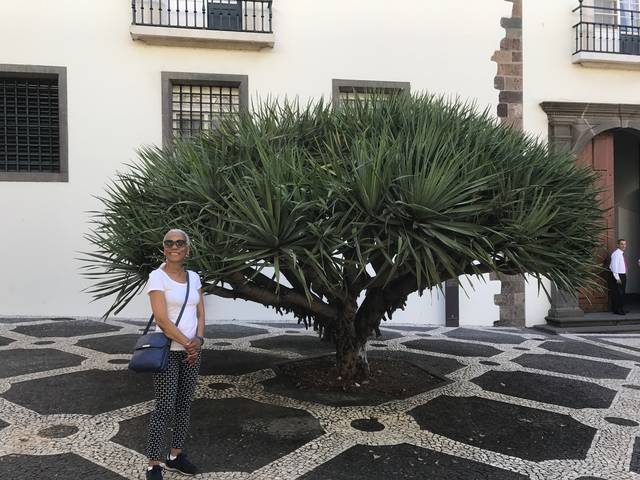Between the Azores Islands to the north and Canary Islands to the south is a minuscule group of islands. We decided to spend a couple of weeks exploring them. Lying just off the North African coast of Morocco, in the
Between the Azores Islands to the north and Canary Islands to the south is a minuscule group of islands. We decided to spend a couple of weeks exploring them. Lying just off the North African coast of Morocco, in the Atlantic at latitude 32 degrees, these islands are the host to visitors from Europe and Africa, but not many folks from Hawaii, so, we thought it would be a great place to explore for new landscape ideas.
The islands are warm with temperatures in the 60s in winter and in the 70s-80s the rest of the year. With around 250,000 residents living on an island a little smaller than Molokai, the main island of Madeira has faced problems of drought and over population. Many Portuguese immigrants to Hawaii came from here and the Azores. The name came from Madeira wine, which was popular at the time in England and was often served with cake. There are two inhabited islands and a scatter of uninhabited desert isles and rocks of volcanic origin. The highest peak is almost 9,000 feet with subtropical forest and even cloud forest and tree ferns that make it feel like a bit like Hawaii.
The capital city of Funchal does not seem as big as it is since it hasn’t gone high rise like Honolulu. The old part of the city has structures up to 500 years in age. Toward the west of its harbor and not visible from the historic city center is the Lido and this is being developed into condos and apartments pushing out traditional banana farms.
Even though the islands were discovered more than 500 years ago and now have a large population, the low terra cotta tile roofs and cobble stone streets on the slopes of the island give the place a feeling of antiquity. Life is tranquil and the impact of cars is minimal compared to Oahu or even Kailua-Kona. Narrow mosaic tiled streets and the numerous tree lined pedestrian promenades further enhance the casual lifestyle. Alii Drive by Kailua Bay would be ideal for these types of landscaped promenades and would take a minimum of effort if we worked together on the concept.
Funchal is on the dry south side of the island. The north side is much wetter as are the mountains. Numerous waterfalls pour over cliffs to create delightful natural swimming pools.
Madeira was created by a large shield volcano more than a million years ago and the rough and rugged coastline in some places is reminiscent of the coastline from Pololu to Waipio. Terraced banana plantations grace the rich volcanic slopes around the island. Thousands of tons of banana fruit are shipped to Portugal annually. Other fruits common are mango, loquat, passion fruit, peach, plum, grape, avocado and citrus.
One major problem we observed was the death of thousands of Canary Island date palms because of the accidental introduction of the red palm weevil from North Africa. This pest not only kills date palms but many other palm species as well.
There are no sandy beaches on the island but pebble beaches lead to exquisitely clear water with temperatures around 75 degrees. We are seeing many species of palms and subtropical fruit trees in the lush landscape but rarely coconut palms. The winter temperatures make the climate marginal for coconut palms but warm enough for royals, ptychospermas, chamaedoreas and many others. It is notable that a great deal of effort is put into landscaping streets and the many parks. The proper maintenance practices on the island are obvious. Any areas capable of supporting trees and flowering vegetation are fully utilized and properly maintained.
We plan to visit the much smaller and dryer island island of Porto Santos with its miles of golden sand beaches and a small population of 5,000 inhabitants. Porto Santos discoveries will be covered next week.



